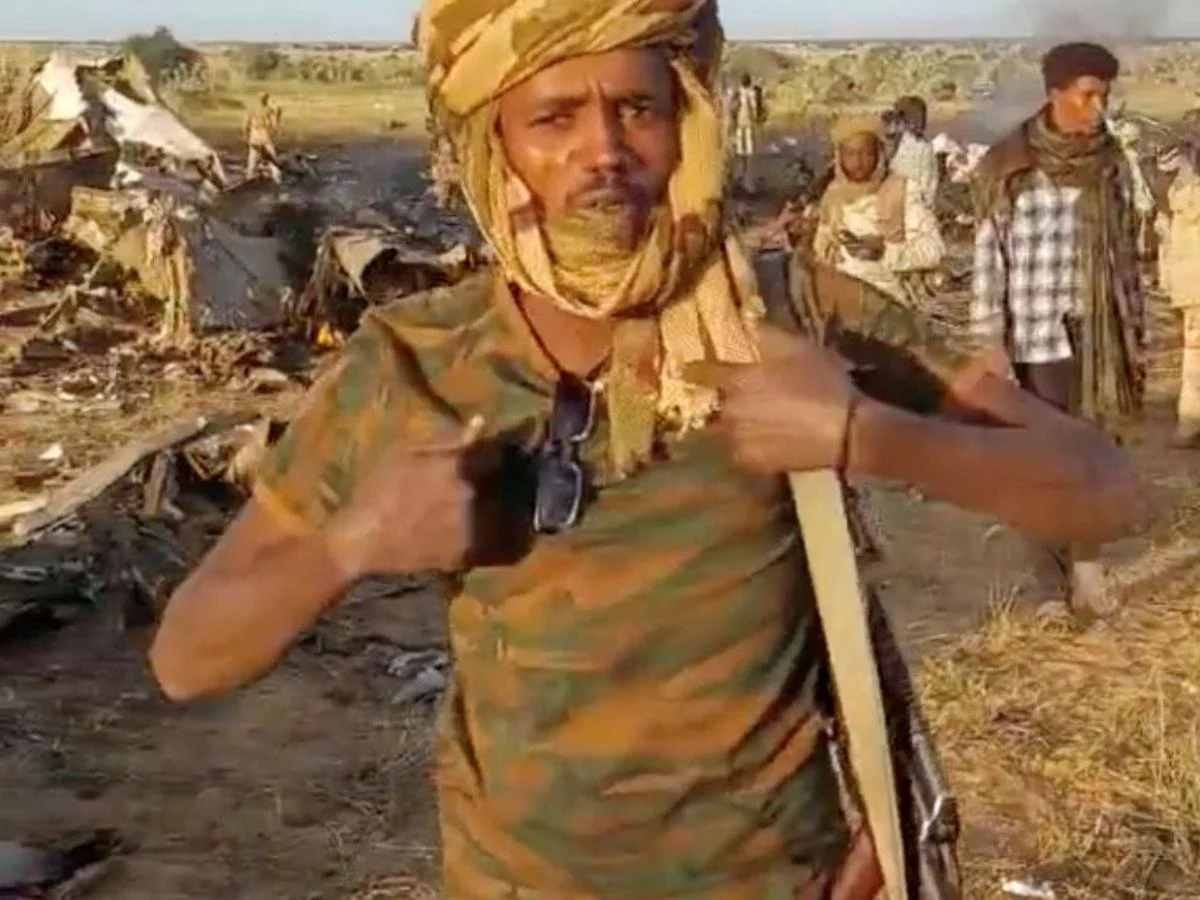
Exclusive: Rivals claim that a plane that went down in Darfur with a suspected Russian crew was supplying the army
According to documents the opposition movement said were discovered in the wreckage, a plane that went down in Sudan’s North Darfur state contained Russian crew members and was being used by the army to resupply the besieged city of al-Fashir.
The event provides insight into the shady supply lines underlying the more than 18-month conflict between the Rapid Support Forces (RSF) and Sudan’s army, which has displaced over 11 million people, led to chronic starvation, and attracted outside forces.
According to flight tracking data and previously unreported information from social media posts, the cargo plane shifted from providing the RSF to the army several months ago. According to a Reuters review of the social media, video, and papers, at least one member of the Russian crew had a history of engaging in arms trafficking.
RSF officials posted video of their soldiers gathered around the flaming remains of the aircraft they claimed to have shot down in al-Malha, north of al-Fashir, early on Monday morning.
The RSF also posted images allegedly showing the identity cards of two Russians they claimed were on board, together with three Sudanese army personnel, in an uncommon disclosure of foreign engagement close to the battle lines.
The jet was later identified by an RSF source as an Ilyushin transport plane, which is used to drop supplies, guns, and ammunition for al-Fashir, where the army and affiliated former rebel groups have been attempting to repel RSF strikes for months.
According to the source, it had just delivered when it was struck.
The London-based non-profit Centre for Information Resilience identified the crash site 80 miles north of al-Fashir and analyzed the footage, finding remnants of the jet’s engine and stabilizer components that match those of a Russian-made Ilyushin IL76 freight plane.
Because of the foliage, the geography, and the contour of the mountains, Reuters was able to verify the videos’ location.
Requests for comment regarding the plane were not answered by the Sudanese army. Reuters was unable to independently verify the plane’s flight path or the manner of its downing.
By comparing footage of their IDs with social media profiles given by the RSF, Reuters was able to identify at least two Russians believed to have been on board the aircraft. To verify the identities of the accused crew members, Reuters used publicly available databases of compromised personal information, facial recognition software, and access to an official Russian database.
According to the Russian embassy in Sudan, the event is being looked into. A request for comment was not immediately answered by the Russian foreign ministry. It is well known that the Sudanese military frequently uses crews from former Soviet nations.
CHANGING ROUTES
Tensions between the army and RSF, who had previously shared power following a coup, flared up as they fought for control ahead of a scheduled shift to civilian administration, sparking the start of the Sudanese war. Foreign assistance has been given to both sides.
A set of safety instructions with the registration number EX-76011 was one of the images of documents that circulated online and in various media following the plane’s downing.
According to a study released this month by the Sudan Conflict Observatory, a monitoring platform supported by the U.S. State Department, the number of an IL-76 that was previously flown by New Way Cargo, an airline that was identified as providing the RSF via Chad with support from the United Arab Emirates, is EX-76011.
According to RSF officials, they were unable to verify the aircraft’s registration number. The likelihood that it was an old photograph from somewhere else was reduced because a reverse image search turned up no previous public postings of images of the safety instruction document.
Reports of the UAE providing military assistance to the RSF have been refuted. The reports were deemed credible by a team of specialists from the United Nations.
Up until November of last year, EX-76011 was flying on routes towards Chad, according to Reuters’ analysis of flight tracking data and satellite imagery.
But according to the aircraft’s most recent data, which dates from December 2023, it was traveling to Port Sudan, the army’s de facto headquarters on the Red Sea coast.
Data from the Swiss intelligence agency CH-aviation indicates EX-76011 was operated by New Way Cargo, an airline based in Bishkek, Kyrgyzstan, and managed by Astraway FZC, a UAE-based aviation service company.
Kyrgyzstan’s civil aviation agency told Reuters the plane was removed from its register and transferred to Sudan on Jan. 12 this year. According to Astraway FZC, in December 2023, it ceased operations with EX-76011 and its crew.
New Way Cargo representatives did not reply.
The safety instructions with the EX-76011 tail number are labelled with the name “NeWay Cargo”. The logo and styling are similar to those of NeWay Logistics LLC, a Dubai-based charter broker.
Erwin Burger, owner and general manager of NeWay Logistics LLC, told Reuters on Monday that they had nothing to do with the airline or the flight.
“Someone is illegally using our company logo,” he said.
RUSSIAN CREW
One of the suspected crew members is Victor Granov, 67, whose work ID, South African driver’s license and expired passport were found in the wreckage, according to footage provided by the RSF. Information from a LinkedIn account and Russian court records show him living in South Africa.
A 2005 report by rights group Amnesty identifies Granov as a South Africa-based businessman formerly associated with Victor Bout, a notorious arms dealer released in a prisoner swap between Russia and the U.S. in 2022.
According to the report, Granov ran two airlines accused of violating an arms embargo in the Democratic Republic of Congo.
Granov’s daughter and ex-wife did not respond to multiple requests for comment. Bout could not be reached for comment.
A second suspected crew member is Anton Selivanets, 33, whose Russian passport was found at the site, according to footage shared by the RSF.
Photos of Selivanets on social networks Instagram and OK show him posing with IL76 planes labelled with the World Food Program (WFP) logo at airports in Ethiopia.
WFP said Selivanets is not a crew member or contractor for the organization. Selivanets’ wife did not respond to text messages requesting comment.
The RSF also sent Reuters a video they said came from a mobile phone recovered from the plane. Reuters identified one of the men in the video as Russian Alexander Kabanov, 61, who posted the same video to his VK and TikTok accounts more than a year ago.
Kabanov’s social media accounts show that he served in the elite airborne troops and spent several years in Africa, particularly in Uganda, Sudan and South Sudan. Reuters could not confirm who the phone belonged to.
Kabanov’s relatives did not respond to requests for comment.
All Categories
Recent Posts
Tags
+13162306000
zoneyetu@yahoo.com



